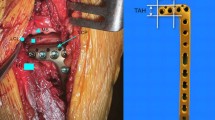Abstract
Minimal invasive technique along with the widespread use of the new pre contoured locking plates (LCP PLT, LISS PLT) has given rise many alignment related problems in fractures of proximal tibia. A significant implant related problem with the use of pre contoured locking plate in proximal tibia fractures is the hardware irritation of the subcutaneous tissue by upper end of plate. This is caused by the large profile of the implant which sits off the bone at the proximal end. A general recommendation made by some is to try and reduce the bone and plate together with the help of pelvic reduction clamps. We have identified this as a source of error in our practice which has a potential to introduce malalignment in tibia, most often discovered post operatively. Here we will describe with relevant cases, the pitfall in the recommended technique and steps to be taken to avoid this error.





Similar content being viewed by others
References
Ricci WM, Rudzki JR, Borrelli J Jr (2004) Treatment of complex proximal tibia fractures with the less invasive skeletal stabilization system. J Orthop Trauma 18:521–527
Stannard JP, Wilson TC, Volgas DA, Alonso JE (2004) The less invasive stabilization system in the treatment of complex fractures of the tibial plateau: short-term results. J Orthop Trauma 18:552–558
Cole PA, Zlowodzki M, Kregor PJ (2004) Treatment of proximal tibia fractures using the less invasive stabilization system: surgical experience and early clinical results in 77 fractures. J Orthop Trauma 18:528–535
Phisitkul P, McKinley TO, Nepola JV, Marsh JL (2007) Complications of locking plate fixation in complex proximal tibia injuries. J Orthop Trauma 21:83–91
Tong GO, Bavonratanavech S (eds) (2006) Minimally invasive plate osteosynthesis. Georg Thieme Verlag, Stuttgart
Wagner M, Frigg R (eds) (2006) Internal fixators concepts and cases using LCP and LISS; 117 step-by-step case descriptions. Georg Thieme Verlag, Stuttgart
Jiang R, Luo CF, Wang MC et al (2008) A comparative study of Less Invasive Stabilization System (LISS) fixation and two-incision double plating for the treatment of bicondylar tibial plateau fractures. Knee 15:139–143
Kwak DS, Surendran S, Pengatteeri YH et al (2007) Morphometry of the proximal tibia to design the tibial component of total knee arthroplasty for the Korean population. Knee 14:295–300
Schutz M, Muller M, Krettek C et al (2001) Minimally invasive fracture stabilization of distal femoral fractures with the LISS: a prospective multicenter study. Results of a clinical study with special emphasis on difficult cases. Injury 32(Suppl 3):SC48–SC54
Schandelmaier P, Partenheimer A, Koenemann B et al (2001) Distal femoral fractures and LISS stabilization. Injury 32(Suppl 3):SC55–SC63
Author information
Authors and Affiliations
Corresponding author
Rights and permissions
About this article
Cite this article
Oh, JK., Sahu, D., Hwang, JH. et al. Technical pitfall while reducing the mismatch between LCP PLT and upper end Tibia in proximal Tibia fractures. Arch Orthop Trauma Surg 130, 759–763 (2010). https://doi.org/10.1007/s00402-009-0949-y
Received:
Published:
Issue Date:
DOI: https://doi.org/10.1007/s00402-009-0949-y




